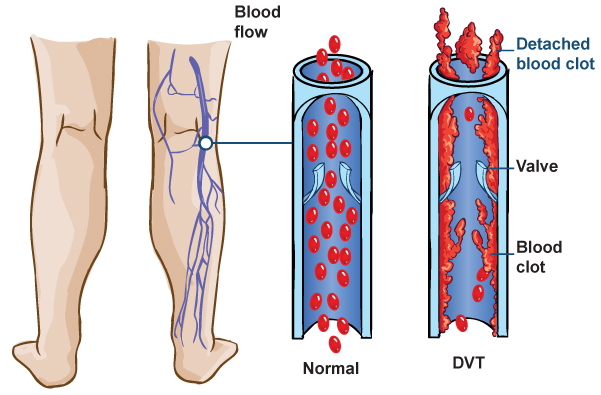By Dr. Holly

In medicine, deep vein thrombosis (also known as deep-vein thrombosis or deep venous thrombosis and usually abbreviated as DVT) is the formation of a blood clot (“thrombus”) in a deep vein. It is a form of thrombophlebitis (inflammation of a vein with clot formation).Deep vein thrombosis commonly affects the leg veins (such as the femoral vein or the popliteal vein) or the deep veins of the pelvis. Occasionally the veins of the arm are affected (if spontaneous, this is known as Paget-Schrötter disease). A DVT can occur without symptoms, but in many cases the affected extremity will be painful, swollen, red, warm and the superficial veins may be engorged. The most serious complication of a DVT is that the clot could dislodge and travel to the lungs, which is called a pulmonary embolism (PE). DVT is a medical emergency, present in the lower extremity there is 3% chance of a PE killing the patient.[1] A late complication of DVT is the post-phlebitic syndrome, which can manifest itself as edema, pain or discomfort and skin problems. Things that can help:
1) detox
2) inc pH: water, diet (inc Oats/Avena & raw garlic)
3) Tincture: Ashwaganda
a. Curcumin
b. Galum aparine
c. Urtica dioca (nettles)
d. Craegas (Hawthorne)
4) Topical: Aesculus (horesechestnut)
a. Galum aparine (cleavers)
b. Curcumin
Here’s to your health!
For more information, contact: Dr Holly at holly@choicesunlimited.ca
Disclaimer: This site is provided for general information only, and is not a substitute for the medical advice of your own doctor or other health care professional. This site is not responsible or liable for any diagnosis made by a user based on the content of this website. This site is not liable for the contents of any external internet sites listed, nor does it endorse any commercial product or service mentioned or advised on any of such sites. Always consult your own health care practitioner.












